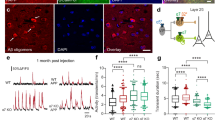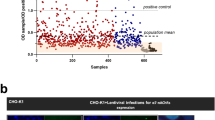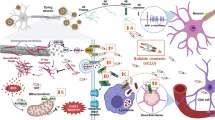Abstract
Aim:
To examine the protective effects of scutellarin (Scu) on rats with learning and memory deficit induced by β-amyloid peptide (Aβ).
Methods:
Fifty male Wistar rats were randomly divided into 5 groups: control, sham operation, Aβ, Aβ+Scu, and Aβ+piracetam groups. Aβ25–35 was injected into the lateral ventricle (10 μg each side). Scu (10 mg/2 mL) or piracetam (10 mg/2 mL was intragastrically administered per day for 20 consecutive days following Aβ treatment. Learning and memory was assessed with Morris water maze test. The protein and mRNA levels of nicotinic acetylcholine receptor (nAChR) α4, α7, and β2 subunits in the brain were examined using Western blotting and real-time PCR, respectively. The activities of acetylcholinesterase (AChE) and butyrylcholinesterase (BuChE) in the brain and plasma were measured using Ellman's colorimetric method.
Results:
In Aβ group, the escape latency period and first platform cross was significantly increased, and the total number of platform crossings was significantly decreased, as compared with the control and the sham operation groups. Both Scu and piracetam treatment significantly reduced the escape latency period and time to cross platform, and increased the number of platform crosses, but there were no significant differences between Aβ+Scu and Aβ+piracetam groups. In Aβ group, the protein levels of nAChR α4 and α7 subunits in the cerebral cortex were significantly decreased by 42%–47% and 58%–61%, respectively, as compared to the control and the sham operation groups. Scu treatment caused upregulation of α4 and α7 subunit proteins by around 24% and 30%, respectively, as compared to Aβ group, but there were no significant differences between Aβ+Scu and Aβ+piracetam groups. The protein level of nAChR β2 subunit had no significant difference among different groups. The mRNA levels of nAChR α4, α7, and β2 subunits were not significantly changed. In Aβ group, the activities of AChE and BuChE in the brain were significantly increased, but were significantly decreased in the plasma, as compared to the control and the sham operation groups. Scu or piracetam treatment restored the activities in brain and plasma nearly to the levels in the control group.
Conclusion:
The results suggest that Scu may rescue some of the deleterious effects of Aβ, possibly by stimulating nAChR protein translation and regulating cholinesterase activity.
Similar content being viewed by others
Log in or create a free account to read this content
Gain free access to this article, as well as selected content from this journal and more on nature.com
or
References
Zhu JT, Choi RC, Li J, Xie HQ, Bi CW, Cheung AW, et al. Estrogenic and neuroprotective properties of scutellarin from erigeron breviscapus: a drug against postmenopausal symptoms and Alzheimer's disease. Planta Med 2009; 75: 1489–93.
Miksicek RJ . Commonly occurring plant flavonoids have estrogenic activity. Mol Pharmacol 1993; 44: 37–43.
Zhu JT, Choi RC, Chu GK, Cheung AW, Gao QT, Li J, et al. Flavonoids possess neuroprotective effects on cultured pheochromocytoma PC12 cells: a comparison of different flavonoids in activating estrogenic effect and in preventing beta-amyloid-induced cell death. J Agric Food Chem 2007; 55: 2438–45.
Wang CN, Chi CW, Lin YL, Chen CF, Shiao YJ . The neuroprotective effects of phytoestrogens on amyloid beta protein-induced toxicity are mediated by abrogating the activation of caspase cascade in rat cortical neurons. J Biol Chem 2001; 276: 5287–95.
Kim H, Park BS, Lee KG, Choi CY, Jang SS, Kim YH, et al. Effects of naturally occurring compounds on fibril formation and oxidative stress of beta-amyloid. J Agric Food Chem 2005; 53: 8537–41.
Henderson VW, Paganini-Hill A, Miller BL, Elble RJ, Reyes PF, Shoupe D, et al. Estrogen for Alzheimer's disease in women: randomized, double-blind, placebo-controlled trial. Neurology 2000; 54: 295–301.
Zhang HF, Hu XM, Wang LX, Xu SQ, Zeng FD . Protective effects of scutellarin against cerebral ischemia in rats: evidence for inhibition of the apoptosis-inducing factor pathway. Planta Med 2009; 75: 121–6.
Lin LL, Liu AJ, Yu XH, Qin LP, Su DF . Protective effects of scutellarin and breviscapine on brain and heart ischemia in rat. J Cardiovasc Pharmacol 2005; 50: 327–32.
Barrantes FJ, Borroni V, Vallés S . Neuronal nicotinic acetylcholine receptor-cholesterol crosstalk in Alzheimer's disease. FEBS Lett 2010; 584: 1856–63.
Bayer TA, Wirths O . Intracellular accumulation of amyloid-beta-a predictor for synaptic dysfunction and neuron loss in Alzheimer's disease. Front Aging Neurosci 2010; 10: 2–8.
Guglielmotto M, Giliberto L, Tamagno E, Tabaton M . Oxidative stress mediates the pathogenic effect of different Alzheimer's disease risk factors. Front Aging Neurosci 2010; 9: 2–3.
Kubo T, Nishimura S, Kumagae Y, Kaneko I . In vivo conversion of racemized beta-amyloid ([D-Ser 26] A beta 1–40) to truncated and toxic fragments ([D-Ser 26]A beta 25–35/40) and fragment presence in the brains of Alzheimer's patients. J Neurosci Res 2002; 70: 474–83.
Perry E, Walker M, Grace J, Perry R . Acetylcholine in mind: a neurotransmitter correlate of consciousness? Trends Neurosci 1999; 22: 273–80.
Mesulam M . The cholinergic lesion of Alzheimer's disease: pivotal factor or side show? Learn Mem 2004; 11: 43–9.
Paterson D, Nordberg A . Neuronal nicotinic receptors in the human brain. Prog Neurobiol 2000; 61: 75–111.
Lippiello P, Letchworth SR, Gatto GJ, Traina VM, Bencherif M . Ispronicline: a novel alpha4beta2 nicotinic acetylcholine receptor-selective agonist with cognition-enhancing and neuroprotective properties. J Mol Neurosci 2006; 30: 19–20.
Viegas C Jr, Bolzani Vda S, Barreiro EJ, Fraga CA . New anti-Alzheimer drugs from biodiversity: the role of the natural acetylcholinesterase inhibitors. Mini Rev Med Chem 2005; 5: 915–26.
Kamal MA, Qu X, Yu QS, Tweedie D, Holloway HW, Li Y, et al. Tetrahydrofurobenzofuran cymserine, a potent butyrylcholinesterase inhibitor and experimental Alzheimer drug candidate, enzyme kinetic analysis. J Neural Transm 2008; 115: 889–98.
Zhao B, Yang HJ, Zhao J . Development of an assay for screening beta-amyloid aggregation inhibitors in vitro and study on inhibitive activity of fridelin. Chin Pharm J 2005; 40: 1474–7.
Paxinos G, Watson C . The rat brain in stereotaxic coordinates. New York: Academic Press; 1982.
Morris R . Developments of a water-maze procedure for studying spatial learning in the rat. J Neurosci Methods 1984; 11: 47–60.
Liu RY, Gu R, Qi XL, Tang Z, Zhao Y, He Y, et al. Decreased nicotinic receptors and cognitive deficit in rats intracerebroventricularly injected with beta-amyloid peptide(1–42) and fed a high-cholesterol diet. J Neurosci Res 2008; 86: 183–93.
An Y, Qi XL, Pei JJ, Tang Z, Xiao Y, Guan ZZ . Amyloid precursor protein gene mutated at Swedish 670/671 sites in vitro induces changed expression of nicotinic acetylcholine receptors and neurotoxicity. Neurochem Int 2010; 57: 647–54.
Ellman G, Courtney D, Andres V, Feather RM . A new and rapid colorimetric determination of acetylcholinesterase activity. Biochem Pharmacol 1961; 7: 88–95.
Yamaguchi Y, Miyashita H, Tsunekawa H, Mouri A, Kim HC, Saito K, et al. Effects of a novel cognitive enhancer, spiro[imidazo-[1,2-a]pyridine-3,2-indan]-2(3H)-one (ZSET1446), on learning impairments induced by amyloid-beta1–40 in the rat. J Pharmacol Exp Ther 2006; 317: 1079–87.
Mazzola C, Micale V, Drago F . Amnesia induced by beta-amyloid fragments is counteracted by cannabinoid CB1 receptor blockade. Eur J Pharmacol 2003; 477: 219–25.
Wang CN, Chi CW, Lin YL, Chen CF, Shiao YJ . The neuroprotective effects of phytoestrogens on amyloid beta protein-induced toxicity are mediated by abrogating the activation of caspase cascade in rat cortical neurons. J Biol Chem 2001; 276: 5287–95.
Jhoo JH, Kim HC, Nabeshima T, Yamada K, Shin EJ, Jhoo WK, et al. Beta-amyloid (1–42)-induced learning and memory deficits in mice: involvement of oxidative burdens in the hippocampus and cerebral cortex. Behav Brain Res 2004; 155: 185–96.
Guan ZZ, Miao H, Tian JY, Unger C, Nordberg A, Zhang X . Suppressed expression of nicotinic acetylcholine receptors by nanomolar? amyloid peptides in PC12 cells. J Neural Transm 2001; 108: 1417–33.
Steven DB, Andrew KJ, Laurence AB, David BS . Nicotinic acetylcholine receptor signalling: roles in Alzheimer's disease and amyloid neuroprotection. Pharmacol Rev 2009; 61: 39–61.
Dani JA, Bertrand D . Nicotinic acetylcholine receptors and nicotinic cholinergic mechanisms of the central nervous system. Annu Rev Pharmacol Toxicol 2007; 47: 699–729.
Lindstrom JM . Nicotinic acetylcholine receptors of muscles and nerves: comparison of their structures, functional roles, and vulnerability to pathology. Ann N Y Acad Sci 2003; 998: 41–52.
Guan ZZ, Zhang X, Ravid R, Nordberg A . Decreased protein levels of nicotinic receptor subunits in the hippocampus and temporal cortex of patients with Alzheimer's disease. J Neurochem 2000; 74: 237–43.
Guan ZZ, Nordberg A, Mousavi M, Rinne JO, Hellström-Lindahl E . Selective changes in the levels of nicotinic acetylcholine receptor protein and of corresponding mRNA species in the brains of patients with Parkinson's disease. Brain Res 2002; 956: 358–66.
Court J, Martin-Ruiz C, Piggott M . Nicotinic receptor abnormalities in Alzheimer's disease. Biol Psychiatry 2001; 49: 175–84.
Kihara T, Shimohama S . Alzheimer's disease and acetylcholine receptors. Acta Neurobiol Exp 2004; 64: 99–105.
Patocka J, Kuca K, Jun D . Acetylcholinesterase and butyrylcholinesterase-important enzymes of human body. Acta Medica (Hradec Kralove) 2004; 47: 215–28.
Rees T, Hammond PI, Soreq H, Younkin S, Brimijoin S . Acetylcholinesterase promotes beta-amyloid plaques in cerebral cortex. Neurobiol Aging 2003; 24: 777–87.
Geula C, Darvesh S . Butyrylcholinesterase, cholinergic neurotransmission and the pathology of Alzheimer's disease. Drugs Today (Barc) 2004; 40: 711–21.
Zhang LJ, Xiao Y, Qi XL, Shan KR, Pei JJ, Kuang SX, et al. Cholinesterase activity and mRNA level of nicotinic acetylcholine receptors (alpha4 and beta2 Subunits) in blood of elderly Chinese diagnosed as Alzheimer's disease. J Alzheimers Dis 2010; 19: 849–58.
Mesulam MM, Asuncion Morán M . Cholinesterases within neurofibrillary tangles related to age and Alzheimer's disease. Ann Neurol 1987; 22: 223–8.
Ulrich J, Meier-Ruge W, Probst A, Meier E, Ipsen S . Senile plaques: staining for acetylcholinesterase and A4 protein: a comparative study in the hippocampus and entorhinal cortex. Acta Neuropathol 1990; 80: 624–8.
Melnikova I . Therapies for Alzheimer's disease. Nat Rev Drug Discov 2007; 6: 341–2.
Howes MJ, Houghton PJ . Plants used in Chinese and Indian traditional medicine for improvement of memory and cognitive function. Pharmacol Biochem Behav 2003; 75: 513–27.
Liu JX, Liu Y, Chen XL, Zhao JJ, Song TS, Qian YH . Breviscapine improves functions of spatial learning and memory of focal cerebral ischemia rats. Zhong Yao Cai (Chinese) 2009; 32: 548–56.
Xiong Z, Liu C, Wang F, Li C, Wang W, Wang J, et al. Protective effects of breviscapine on ischemic vascular dementia in rats. Biol Pharm Bull 2006; 29: 1880–5.
Liu H, Yang XL, Zhou LZ, Xu HB . Study on reactive oxygen species scavenging effects of scutellarin. J Chin Med Mat 2002; 25: 491–3.
Liu H, Yang XL, Wang Y, Tang XQ, Jiang DY, Xu HB . Protective effects of scutellarin on superoxide-induced oxidative stress in rat cortical synaptosomes. Acta Pharmacol Sin 2003; 24: 1113–7.
Xu W, Zha RP, Wang WY, Wang YP . Effects of scutellarin on PKC in PC12 cell injury induced by oxygen and glucose deprivation. Acta Pharmacol Sin 2007; 28: 1573–9.
Hong H, Liu GQ . Protection against hydrogen peroxide-induced cytotoxicity in PC12 cells by scutellarin. Life Sci 2004; 74: 2959–73.
Croisile B, Trillet M, Fondarai J, Laurent B, Mauguière F, Billardon M . Long-term and high-dose piracetam treatment of Alzheimer's disease. Neurology 1993; 43: 301–5.
Bering B, Muller WE . Interaction of piracetam with several neurotransmitter receptors in the central nervous system. Arzneim Forsch 1985; 35: 1350–2.
Acknowledgements
This work was financed by grants from the National Natural Science Foundation (No 30870986), the Foundations in the Ministry of Science and Technology of China (2006DFA33530), and the Foundations in the Guizhou Province of China.
Author information
Authors and Affiliations
Corresponding author
Rights and permissions
About this article
Cite this article
Guo, Ll., Guan, Zz. & Wang, Yl. Scutellarin protects against Aβ-induced learning and memory deficits in rats: involvement of nicotinic acetylcholine receptors and cholinesterase. Acta Pharmacol Sin 32, 1446–1453 (2011). https://doi.org/10.1038/aps.2011.115
Received:
Accepted:
Published:
Issue date:
DOI: https://doi.org/10.1038/aps.2011.115
Keywords
This article is cited by
-
Scutellarin ameliorates neonatal hypoxic-ischemic encephalopathy associated with GAP43-dependent signaling pathway
Chinese Medicine (2021)
-
Neurotrophic function of phytochemicals for neuroprotection in aging and neurodegenerative disorders: modulation of intracellular signaling and gene expression
Journal of Neural Transmission (2017)
-
Scutellarin as a Potential Therapeutic Agent for Microglia-Mediated Neuroinflammation in Cerebral Ischemia
NeuroMolecular Medicine (2016)



